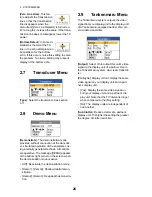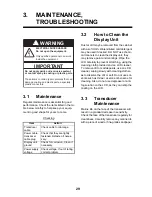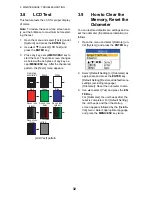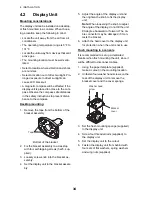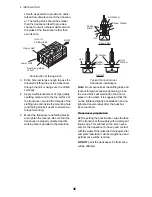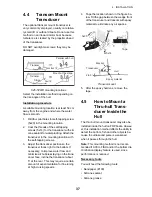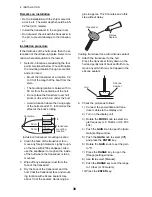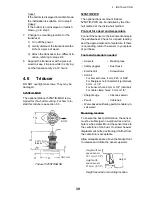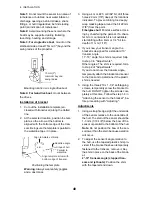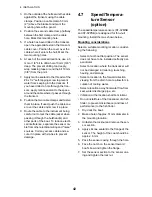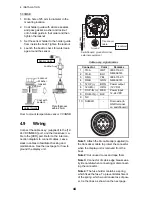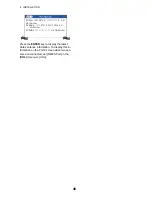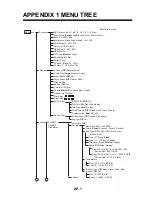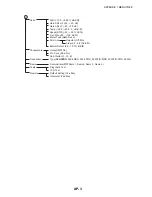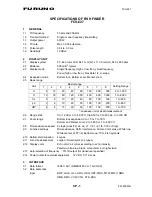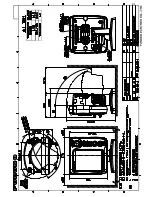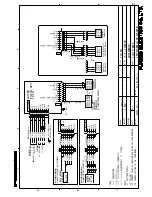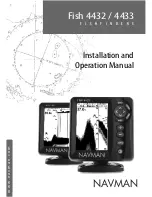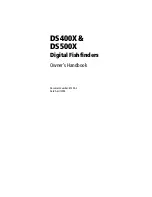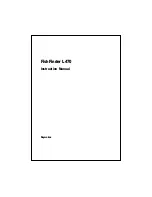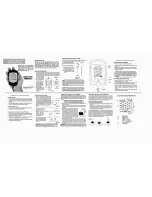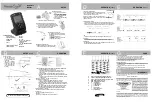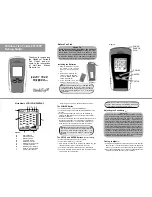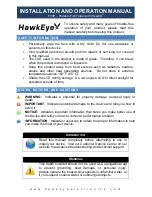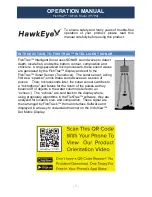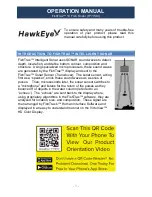
4. INSTALLATION
42
3. On the outside of the hull secure the cable
against the transom using the cable
clamps. Position a cable clamp 50 mm
(2") above the bracket and mark the
mounting hole with a pencil.
4. Position the second cable clamp halfway
between the first clamp and the cable
hole. Mark this mounting hole.
5. If a hole has been drilled in the transom,
open the appropriate slot in the transom
cable cover. Position the cover over the
cable where it enters the hull. Mark the
two mounting holes.
6. At each of the marked locations, use a 3
mm or 1/8" bit to drill a hole 10 mm (3/8")
deep. The prevent drilling too deeply,
wrap masking tape around the bit 10 mm
(3/8") from the point.
7. Apply marine sealant to the threads of the
#6 x 1/2" self-tapping screw to prevent
water from seeping into the transom. If
you have drilled a hole through the tran-
som, apply marine sealant to the space
around the cable where it passes through
the transom.
8. Position the two cable clamps and fasten
them in place. If used, push the cable cov-
er over the cable and screw it in place.
9. Route the cable to the instrument being
careful not to tear the cable jacket when
passing it though the bulkhead(s) and
other parts of the boat. To reduce electri-
cal interference, separate the sensor ca-
ble from other electrical wiring and "noise"
sources. Coil any excess cable and se-
cure it in place with zip-ties to prevent
damage.
4.7
Speed/Tempera-
ture Sensor
(option)
The speed/temperature sensors (ST-02MSB
and ST-02PSB) are designed for thru-hull
mounting. Install them as shown below.
Mounting considerations
Select a suitable mounting location, consider-
ing the following:
• Select a mid-boat flat position. The sensor
does not have to be installed perfectly per-
pendicular.
• Select a location where the transducer will
not be damaged in trailering, launching,
hauling, and storage.
• Select a location in the forward direction
viewing from the drain hole, to allow for cir-
culation of cooling water.
• Select a location away from water flow from
keel, water discharge pipe, etc.
• Vibration at the location shall be minimal.
• Do not install fore of the transducer of a fish
finder, to prevent disturbance (and loss of
performance) to the fish finder.
1. Dry-dock the boat.
2. Make a hole of approx. 51 mm diameter in
the mounting location.
3. Unfasten the locknut and remove the sen-
sor section.
4. Apply silicone sealant to the flange of the
sensor. The height of the coat should be
approx. 6 mm
5. Pass the sensor casing through the hole.
6. Face the notch on the sensor toward
boat's bow and tighten the flange.
7. Set the sensor section to the sensor cas-
ing and tighten the locknut.
Summary of Contents for FCV-627
Page 1: ...FISH FINDER FCV 627 OPERATOR S MANUAL www furuno com B R I L L GAIN ...
Page 62: ...D 1 ...
Page 63: ...D 2 ...

